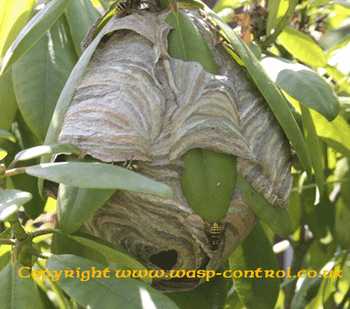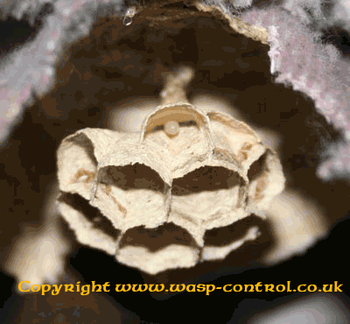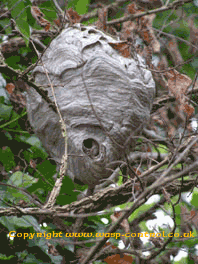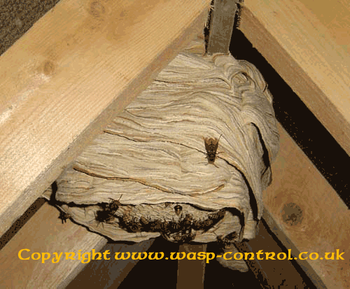Wasp Nest
How wasp nests are constructed
The Intricate Construction Process
Dive into the captivating world of wasp nests, intricate structures ingeniously crafted from wood sourced by wasps themselves. Fence panels, garden sheds, and various available supplies become the building blocks for these fascinating creations. The queen wasp kickstarts the construction in spring, emerging from winter hibernation. Explore the detailed life-cycle of wasps for a comprehensive understanding of their behavior.
Variable Growth Rates: Factors at Play
Wasp nests don't adhere to a one-size-fits-all growth pattern; instead, their development varies based on several factors. Food availability during early summer emerges as a significant influence. In years with limited food supply, the number of individual wasps may not reach typical levels. Additionally, the availability of nest-building materials, such as untreated dead wood from various sources, plays a crucial role in shaping nest growth.
Dispelling Myths: Understanding Wasp Swarming Behavior
Contrary to popular beliefs, wasps do not swarm in the same manner as honey bees. Swarming occurs primarily when the nest is tampered with or under attack during treatment. Wasps, however, do engage in swarming behavior while feeding, but it is distinct from the organized swarming of honey bees and occurs away from the nest.
Late Summer Challenges: Human-Wasp Interaction
As late summer transitions into autumn, wasps face a dwindling food supply within the nest. This can lead to increased interaction and competition with humans for sugary foods, particularly in places like pub gardens.
Decoding Nest Activity: Signs of a Live Nest
Determining the activity status of a wasp nest becomes straightforward from midsummer to late autumn. Observe the nest from a safe distance; if you spot wasps walking over the exterior or arriving and departing, the nest is active. This simple visual cue allows for easy identification of a live and potentially problematic nest.

How Wasp Nests are made
Spring Initiatives: Queen's Nest Construction
In the spring, the wasp nest construction process commences under the guidance of the queen. The initial step involves the queen building a petiole, a singular stalk serving as the foundation for the nest. At the end of this petiole, the queen meticulously crafts a hexagonal-shaped cell. Following this, approximately six more cells are strategically formed around the central one.
Cell Creation and Egg Laying
Each hexagonal cell is meticulously constructed by the queen, who subsequently lays an egg within each one. This marks the beginning of the intricate life cycle of wasps within the nest.
Worker Takeover: Development Stages
As the eggs hatch, the emerging larvae undergo developmental stages until they pupate into fully grown adult wasps. These new worker wasps play a pivotal role in the ongoing construction of the nest. Their responsibilities extend beyond construction, as they assume various tasks, leaving the queen with the primary duties of egg laying and nest control.
Queen's Evolving Role
With the emergence of worker wasps, the queen transitions into a more specialized role. Her primary functions now focus on laying eggs and maintaining control over the nest. This shift highlights the collaborative nature of wasp colonies, with distinct roles ensuring the survival and prosperity of the community.
Dive Deeper into the Wasp Life Cycle
For a more in-depth exploration of the wasp life cycle and detailed insights into how these intricate nests are meticulously built, delve into our comprehensive guide on wasp life cycles and nest construction. Understanding these processes provides valuable insights into the fascinating world of these remarkable insects.

Why are some wasps aggressive and some calm?
Ever wondered why some wasps seem aggressive while others maintain a calm demeanor? It all boils down to the queen's influence on the nest's "mood." Each queen has a unique personality, and this individuality determines whether the colony will be highly aggressive or relatively calm.
The queen takes charge of emitting pheromones throughout the nest, which serve as a silent language to communicate with the workers. These chemical signals convey crucial information, letting the workers know whether everything is okay or if the nest is facing potential danger.
So, the next time you observe wasps exhibiting different behaviors, remember it's not just chance—it's the intricate interplay of the queen's personality and the pheromones she releases that shapes the overall temperament of the nest.
What is a wasp nest made from?
Wasps ingeniously craft their nests using dead wood as the primary building material. In the onset of spring, the queen wasp initiates the construction process by gathering old dead wood from diverse sources like untreated fence panels, sheds, and even garden furniture.
As the nest advances and worker wasps come into play, they seamlessly take on the responsibility of collecting nest materials. These industrious workers bring the collected material back to the nest, where it undergoes a transformation. The chewed wood is turned into a paste, a crucial substance utilized by adult workers to effectively expand and fortify the nest.
The wood pulp mixture, integral to nest construction, is not only a blend of chewed wood but also incorporates a specific amount of wax. This addition serves a dual purpose, contributing to the structural integrity of the nest while providing essential waterproofing. This streamlined process underscores the collaborative efforts within the wasp colony, showcasing the intricate teamwork involved in creating and maintaining a secure home for the community.

Common Wasps
English (Common) Wasps - Vespula Vulgaris
Common wasps, scientifically known as Vespula Vulgaris, display remarkable versatility in nest locations. These common wasps construct nests in a variety of places, ranging from lofts, sheds, and old rabbit burrows to vole burrows in the ground. They also inhabit less conventional spaces such as inside air bricks, cavity walls, and chimneys. Their preference for dry and undisturbed areas is evident, with a tendency towards higher locations, although exceptions exist.
German Wasps - Vespula Germanica
European wasps, or Vespula Germanica, showcase a distinct nesting behavior. They prefer to build their nests in bushes, hedges, and trees. Despite their impressive camouflage, their nests, resembling large hanging grey football-type objects, become noticeably visible once detected. Unlike their English counterparts, German wasps exhibit a preference for lower locations, although their adaptability means they might occasionally choose higher positions.
The Aggression Debate: English vs. German Wasps
Amid discussions about which type of wasp is more aggressive, opinions vary. Some pest controllers assert that German wasps are more aggressive, while others argue in favor of English wasps. In practice, the aggressiveness of either type may be subjective, but an observation leans towards English wasps being more prone to attack when their nests are interfered with. Caution is advised when dealing with any wasp nest, emphasizing the importance of handling these stinging insects with care and expertise.
What are Hornet nests made from?
Demystifying Hornet Nests and Nest Reuse
Hornet nests share similarities with wasp nests, as they are constructed from the same materials using a similar process employed by wasps in their nest-building endeavors.
Will Wasps and Hornets Reuse Old Nests?
A common misconception revolves around the belief that Wasps and Hornets might reuse nests from previous years. However, it's essential to clarify that both wasps and hornets do not reuse nests. Instead, they embark on constructing a new nest each year.
Nest Reuse Among Bees
In contrast, bees exhibit a different behavior. Bees may reuse an old nest, especially when an existing honeycomb has been established. In such cases, if there are remaining stores of honey within the comb, bees might opt to utilize the old nest. This stands as a distinct practice from wasps and hornets, emphasizing the unique nesting behaviors exhibited by these different species.
